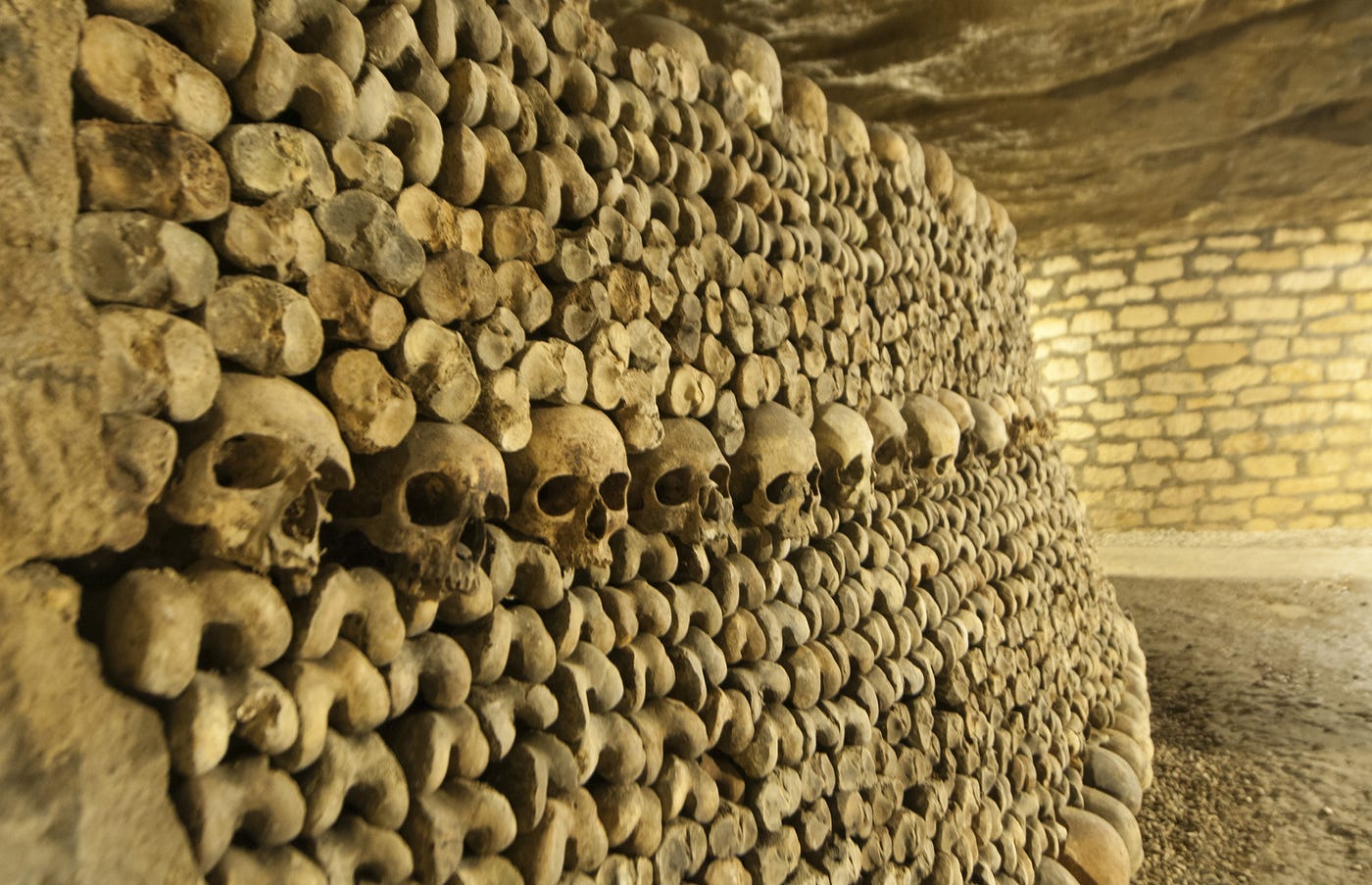Imagine stepping into a world beneath the bustling streets of Paris, where echoes of history whisper through ancient tunnels and bones line the walls. Welcome to the Paris Catacombs—a hidden realm that unveils a fascinating story, waiting to be explored. These underground wonders hold secrets that go beyond mere skeletons; they reveal tales of love, loss, and resilience against time. As you descend into this eerie labyrinth, prepare for an adventure like no other.

Whether you’re an avid history buff or simply curious about what lies beneath your feet, the Catacombs promise surprises at every turn. Buckle up as we take you on a journey through six astonishing features of this captivating subterranean landscape!
Table of Contents
History and Purpose of the Catacombs
The Paris Catacombs trace their origins back to the late 18th century. At that time, the city faced a pressing issue: overflowing cemeteries.

The city’s population had been steadily growing, and the overflowing cemeteries posed a major health risk. In 1786, a wall around the Les Innocents cemetery collapsed, spilling decomposing bodies onto the streets. This event sparked the creation of the Catacombs as a solution to the overcrowding problem.
Paris was growing rapidly and its cemeteries were unable to keep up with the increasing number of burials. This led to overcrowding, unsanitary conditions, and a foul odor that permeated the city. In addition, the cemeteries were located within the city limits, posing a health risk to residents.
In 1780, an inspector of quarries named Guillaumot proposed using the abandoned quarries beneath the city as a burial site. The underground tunnels had been used for centuries to extract limestone for construction, but had since been abandoned.
The idea was initially met with resistance from religious authorities and Parisians who believed in traditional burial practices.
However, after several years of public health concerns, overcrowded cemeteries, and a series of cave-ins caused by collapsing tunnels, King Louis XVI finally approved the plan in 1785.
The task of transferring remains from the cemeteries to the catacombs began in 1786. It took two years for workers to transfer bones from various cemeteries into the catacombs. The bones were arranged in an organized manner along with decorative elements such as crosses and plaques bearing inscriptions.
The catacombs opened to the public in 1809 and have since become a popular tourist attraction.
The solution? To create an underground ossuary. This transformation began in 1786. The bones from various cemeteries were transferred here, primarily from Les Innocents.
These dark tunnels, spanning over 200 miles, became both a burial site and a response to overcrowding above ground. They served as a pragmatic approach to managing the city’s dead.
As years passed, they evolved into more than just a graveyard. The catacombs turned into an intriguing monument of Paris’s history—an eerie yet fascinating testament to life and death intertwined beneath bustling streets.
Today, they hold stories of generations past while captivating modern visitors drawn by curiosity and mystery.
The Process of Creating the Catacombs
The creation of the Paris Catacombs was a monumental endeavor that began in the late 18th century. Initially, it started as a solution to overcrowded cemeteries. The remains of over six million Parisians were relocated underground.
Workers excavated limestone quarries beneath the city, which had been used for centuries. They transformed these dark tunnels into vast chambers filled with bones and skulls.
Each pile of bones was arranged artistically, turning what could have been a gruesome sight into an eerie display. The meticulous stacking showcases both reverence and creativity.
As you wander through this labyrinthine space, you’ll encounter inscriptions on the walls. These serve as reminders of mortality and the transient nature of life itself.
Innovative engineering techniques helped ensure structural integrity while accommodating thousands who would eventually visit this hidden wonder. This process marked an essential chapter in Paris’s history—a blend of necessity and artistry buried deep below the bustling streets above.
Unique Features and Surprises in the Catacombs
As you wander through the dimly lit corridors of the Paris Catacombs, several unique features catch your eye. The ossuary housing over six million skulls and bones is a striking reminder of mortality. Arranged in intricate patterns, these skeletal displays are as artistic as they are haunting.
Among the surprises, you’ll find inscriptions on walls that tell stories of love and loss. Some phrases echo sentiments from centuries past, inviting reflection amidst the eerie ambiance.
Hidden chambers reveal unexpected sculptures crafted from bone—an unusual blend of artistry and history. These hidden gems showcase human creativity even in darkness.
The temperature drops noticeably as you descend further underground, transforming your experience into something otherworldly. With each twist and turn, there’s a sense of discovery waiting to unfold around every corner. What lies ahead remains a mystery until you take that next step deeper into this subterranean wonderland.
Mysterious Legends and Stories Surrounding the Catacombs
The Paris Catacombs are steeped in mystery, with tales that stir the imagination. One popular legend speaks of an underground society known as the “Cataphiles,” who explore hidden chambers and secret tunnels. These adventurers often claim to encounter echoes of the past — whispers from long-gone souls.

Another legend speaks of a hidden room filled with treasures plundered during the French Revolution. The exact location of this chamber remains a mystery, adding to the catacombs’ allure.
Another legend tells of a group of workers who were tasked with clearing out bones from the catacombs in the late 18th century. As they dug deeper, they came upon a strange room filled with statues and altars dedicated to an unknown deity. Some believe that this was evidence of a secret cult that used the catacombs for their rituals.
There are also stories of paranormal activity within the catacombs. Visitors have reported feeling a strong presence or hearing disembodied voices and footsteps. Some claim to have seen ghostly figures roaming the tunnels, while others have experienced unexplained cold spots or sudden drops in temperature.
One of the most chilling legends surrounding the Paris Catacombs is that of “The Gatekeeper.” According to this story, there is a figure dressed in dark robes who roams the tunnels, guarding its secrets. It is said that anyone who crosses paths with The Gatekeeper will be cursed or never be able to find their way out of the catacombs.
There are also tales of missing persons who entered the catacombs and were never seen again. Some people believe that these individuals became lost in the maze-like tunnels and succumbed to starvation or dehydration. Others speculate that they fell victim to The Gatekeeper or
Another chilling story involves a lost explorer who wandered too deep into the labyrinthine passages. According to lore, he stumbled upon a gathering of spirits engaged in eternal festivities, forever trapped between worlds. His cries for help echoed unheard.
Some say that strange lights flicker within the catacombs at night, leading visitors astray. Others report feelings of being watched or followed by unseen presences as they traverse these ancient bones.
These legends add an alluring layer of intrigue to what is already one of Paris’s most fascinating attractions. The atmosphere here invites questions that linger long after you’ve left its dark embrace.
Tips for Visiting the Catacombs
Visiting the Paris Catacombs can be an unforgettable experience. To make the most of it, arrive early to avoid long queues. The catacombs are popular, and waiting in line can eat up your valuable time.
Dress comfortably. The temperature underground is cooler than above ground, so layers are a good idea. Sturdy shoes will help you navigate uneven paths and steps.
Consider booking tickets online in advance. This allows you to skip some of the lines and gives you more time to explore the eerie beauty below surface level.
Don’t forget your camera! While flash photography isn’t allowed, capturing the haunting atmosphere with natural light is still possible.
Keep an open mind about what you’ll encounter down there—those 6 surprising underground wonders await discovery at every turn!
Conclusion: Why You Should Experience the Paris Catacombs
Exploring the Paris Catacombs is an adventure like no other. These underground wonders offer a glimpse into history that few places can match. As you wander through the dimly lit tunnels, you’ll be surrounded by remnants of lives long past. Each skull and bone tells a story, sparking curiosity about those who came before us.
Visiting the catacombs invites introspection and awe. The atmosphere is both haunting and fascinating, making it a unique experience for every traveler. Whether you’re drawn by history, architecture, or simply a sense of adventure, this site promises to leave an impression.
The tales intertwined with these bones add another layer of intrigue. Myths about spirits wandering the tunnels or hidden treasures waiting to be discovered only deepen your exploration’s allure.
If you’re planning a trip to Paris, make sure the catacombs are on your itinerary. They offer more than just sights; they provide insights into life, death, and everything in between within one of Europe’s most iconic cities. Embrace the unexpected discoveries that await beneath the bustling streets above—there’s so much more to uncover in this city rich with history!
Click here for related details.
Stay tuned on Travelyas for insight details.

